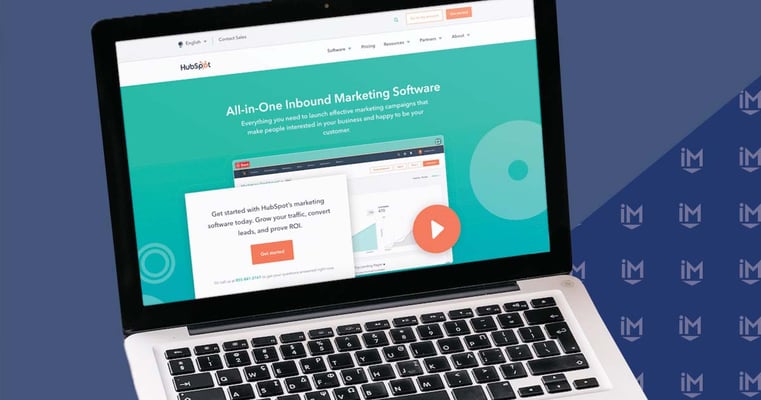Subscribe now and get the latest podcast releases delivered straight to your inbox.
The Ultimate HubSpot Marketing Migration Checklist

Jun 30, 2020

You always remember your first… migration to the HubSpot Marketing Hub.
Mine was in 2013. I had just started working at a small SaaS company, and our leadership team had decided to go all-in on inbound marketing. We were shopping for agency partners and preparing to make the leap from Pardot to HubSpot.
As a young marketing professional, this was a big new project that I was excited to take on. We knew where we wanted to go, but it turned out that the process of getting there was a little messy (to say the least).
On a random Monday morning, the CEO of my organization came into my office and said:
“We’ve decided to pull the trigger! We’re moving off of Pardot by Friday. Start downloading anything we need to save.”
Why the rush? Cost savings, of course. We didn’t want to be locked into another contract with Pardot after the end of the month, so time was of the essence.
🔎 Related: Our ultimate Salesforce to HubSpot CRM migration checklist
But the timing of this request was not exactly ideal. My marketing manager was out of town on an African Safari, and completely unreachable — which meant that I, the marketing associate who had started less than six months ago, was going to need to tackle this assignment solo.
I spent all week diligently downloading data files, copying HTML source code for marketing emails, and generally grabbing anything and everything I could find, but I really had no idea what I was doing.
The process was messy, frantic, and unnecessarily stressful… but somehow by the end of the week, we were up and running on a new marketing automation platform.
Why would I migrate anything ever again?
As the story above illustrates, migrations are hard.
Companies tend to avoid them. We get comfortable with our existing processes, systems and softwares. Plus (as a whole) we don’t like change.
So, why the heck does anyone migrate to a new marketing automation platform?
Because sometimes sticking with the status quo means sacrificing the long-term growth potential of your organization.
Upgrading your marketing automation software is an investment, both in terms of time, financial resources, and the costs associated with switching. But change may be necessary to stay ahead of the curve and ensure that you have the tools in place to keep up with the competition.
While the project shouldn’t be taken lightly, you also can’t ignore the potential benefits of making the move:
- Increased team efficiency
- Alignment between marketing and sales
- Advanced automation features that may not be available in your current CRM
- CRM features that are a better fit for your business
- More robust reporting and a better understanding of marketing ROI
- Ability to to scale up over time and integrate new departments (by adding on Sales Hub, Service Hub, etc.)
If you know how to prepare, you can make the process much less painful and hasty than my first experience.
The ultimate HubSpot Marketing migration checklist
When you’re ready to bite the bullet and make the switch, here’s your ultimate checklist for how to migrate to HubSpot:
Plan to take on a major project
-
Set aside enough time: Timing is everything, and HubSpot migrations are no different. Make sure you know when your existing contract obligations are set to expire and give yourself enough time to shop around and find the right HubSpot tier and mix of add-ons to fit your needs.
-
Develop organizational buy-in: Lack of buy-in will doom your migration from the start. Keep in mind that teams are often resistant to change, so don’t breeze past this step! Make sure that all stakeholders know why this move is essential for the growth of the business and are fully aligned with what you are trying to achieve.
-
Create a clear plan of attack: Once you decide to make a move, you need a well-defined strategy and a clear timeline of the migration process. Lean on your team’s past experience with software migrations (or the migration experts at HubSpot Support) to set accurate time estimates and clear milestones.
-
Assign a dedicated project manager: Someone needs to own this plan of attack. Make sure the point person has the bandwidth to take on this big project and the necessary support from within the organization to get it done.
The foundation of any marketing database is contact information
-
Only import clean (and lean!) contact data: Once you’ve signed up for HubSpot, one of your first onboarding steps will be to import existing data files. But make sure to clean out those .csv files before you start uploading! Clean data will ensure that you can properly segment lists, target key accounts, and generally use HubSpot’s database functionality.
-
Create custom data points for non-standard information: Your business is unique, and the data you capture and store in your database is unique too! Make sure to set up custom record properties to save and transfer that valuable data that’s unique to your organization. Remember your ability to segment is ultimately limited by the quality of your data, so you want to move as much information over as possible (even if it requires a little extra effort) to ensure better targeting in the future.
-
Always be mindful of your contact limits: Contact records are essential to any CRM, but be mindful of your HubSpot contact limits! Depending on your pricing package, HubSpot will charge you up to $50/month per 1,000 additional contacts. You want to ensure that you purchase enough space for your existing data, and extra room to grow your contacts lists as your business grows.
Know which marketing assets can easily move between systems
-
You’ll need to move over all of your images: The last thing anyone wants are broken images on your marketing assets! All website and blog images will need to be uploaded and stored within the HubSpot File Manager so that they can be added to new emails, website pages, and blog posts.
-
And don’t forget your video files: Similar to images, you can use HubSpot Video to store and embed video content for HubSpot Marketing Pro and Enterprise users. Keep in mind HubSpot Video is powered by Vidyard, so you will need to agree to Vidyard’s terms and conditions before you can start uploading and using video content in your HubSpot portal.
-
Organize and upload all of your premium download offers: Premium content offerings are a great way to generate new database leads. When you’re in the process of switching CRMs, make sure that you have up-to-date copies of all premium content PDFs so that these files can also be added to your HubSpot File Manager and included in new conversion paths.
-
Reconnect all of your social media: HubSpot allows you to easily connect your existing Facebook, Instagram, Twitter, Linkedin, and YouTube accounts so that you can easily share social content and track performance from within the tool. As an added bonus, you can also run ROI reports to see which social media channels actually generated closed/won customers.
Know that moving certain marketing assets will take some heavy lifting
-
Connect your existing domains: Connecting your domain is a relatively straightforward process that allows you to publish content on the web. It’s an essential step to publishing website pages, blog posts, or sending branded emails. Make sure to have all relevant information from your domain name system (DNS) provider on hand before you start the setup process.
-
Move over your blog content: Migrating your blog content is a whole separate project, but don’t worry — IMPACT’s Daniel Escardo is here to help! Of course, you can use HubSpot without migrating your blog to the platform, but if you choose to migrate your blog content, you’ll be able to build strong closed-loop reporting and truly understand content ROI.
-
Migrate your entire website: Migrating your entire website to HubSpot can be a major undertaking. Luckily, HubSpot’s migrations team is here to help and can recreate your existing website on HubSpot's CMS. Again, you can use HubSpot without hosting your website on the HubSpot CMS, but you’ll see stronger, more relevant reporting if you fully integrate all of your marketing assets into the platform.
Know that some assets just won’t move between systems and you’ll need to recreate them entirely
-
Build out lead capture forms: Your database should continue to grow over time. Lead collection forms will need to be recreated within your HubSpot portal, but once they’re up and running, you can easily convert website traffic into leads that you can actually follow-up with.
-
Recreate landing pages / thank you pages: Conversion paths will also need to be migrated or recreated, but luckily HubSpot’s drag-and-drop landing page editor makes this process quick and easy (even for non-developers!) Ensure that your conversion paths provide clear next steps, and drive your website visitors to more valuable content offerings.
-
Inspire conversion with call-to-action buttons: HubSpot’s CTA buttons allow the website visitor to easily see where to go next. These types of visual elements will need to be individually created in your HubSpot portal to accurately track each element of your conversion path.
-
Create segmented active lists: Static contact lists can be easily uploaded into your HubSpot portal, but segmented or “active” lists based on a unique combination of contact property filters must be recreated within the lists area of the tool. Remember, your ability to segment is limited by the amount of contact data you store in HubSpot, so make sure to import as much relevant information as possible and continue to gather relevant data at each contact conversion point.
-
Rebuild email templates: Marketing emails will most likely need to be recreated within your new HubSpot portal, but HubSpot’s drag-and-drop email editor makes the process simple and straightforward. HubSpot also has pre-built drag-and-drop templates that can be easily customized to fit the look and feel of your brand.
-
Work smarter with automated email drips: Once you’ve created your email marketing content, you can use HubSpot workflows to recreate your automated marketing email drips. HubSpot’s marketing automation is the powerhouse that drives further investment in the tool. Once you see the benefits of automation, you’ll never look back.
-
Tie it all together with campaign tracking: Creating HubSpot campaigns allows you to tie conversion path elements together to see how the marketing campaign performs as a whole. Once you’ve successfully recreated your conversion paths, you should use HubSpot Campaigns to property tag and organize related marketing assets.
A new system requires new skill sets
-
Understand where to find free educational resources: In any major project it’s important to know where you can turn if you get stuck. HubSpot’s Knowledge Base and the HubSpot Academy provide free educational resources to ensure that your migration goes as smoothly as possible.
-
Ongoing training can help you maximize your HubSpot investment: Remember: migration is just the first step. Learning to use the tools to drive traffic, leads, and sales is a much longer journey that requires ongoing training and support. If you’re ever in doubt that you’ve made the right decision — ask the experts. IMPACT’s HubSpot trainers are here to make sure that you get the most out of your marketing automation software investment.
The bottom line
It’s true — HubSpot migrations are no small task. But there’s no need to fear with this ultimate HubSpot Marketing migration checklist in your back pocket.
All it takes is a well-defined plan of attack, an understanding of which assets can easily move over (and which ones can’t), and a strong commitment to learning (and loving!) your new marketing CRM.

